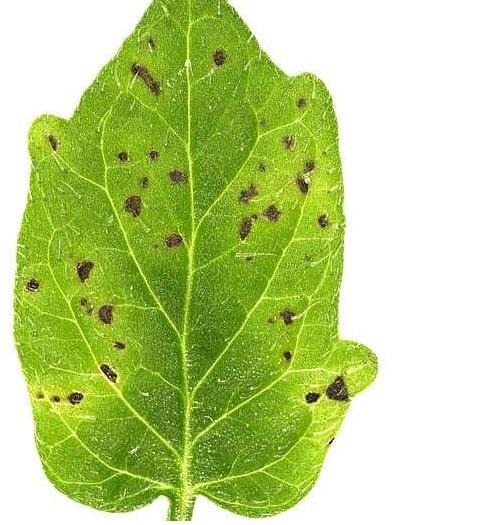By Jeff Mulhollem

A tomato plant leaf infected with bacterial speck, the disease caused by P. syringae pv. tomato DC3000.
Microbial communities naturally living on the leaves and stems of tomato plants can be manipulated to suppress diseases that reduce productivity, according to Penn State researchers, offering hope that growers someday can apply these mixtures of bacteria and fungi to protect plants and improve harvests.
In a new study that involved a greenhouse full of four lines of young tomato plants representing different treatments and control groups, researchers repeatedly "passaged" or transferred microbes—initially gathered from leaves of healthy tomato plants in the field—from one plant to another, which were subsequently inoculated with the bacterial speck pathogen.
After multiple transfers or passages of the microbes, disease symptoms such as brown-to-black lesions on leaves began to wane and, by the ninth passage, declined by nearly half.
This discovery has implications beyond tomato and even vegetable plants, suggested Kevin Hockett, assistant professor of microbial ecology in the College of Agricultural Sciences, who is a co-author on the research paper. The goal, he said, is to develop a process that enables growers to employ microbial communities in the field.
"We're trying to find a way that we can use the natural ecosystems in the fields to benefit farmers and prevent plant diseases, and I think there's a lot of potential here going forward," he said. "We're working with bacterial diseases now, but I don't see any reason why we couldn't test this with fungal diseases as well as other bacterial diseases in other vegetable crops. This may be an approach that can be applied widely and change the way we think about biological controls, even for other crops."
The suppressive effects of microbial communities in the soil on plant diseases are well known, noted lead researcher Hanareia Ehau-Taumaunu, who will graduate in August with a doctoral degree in plant pathology, but this was the first study to show that microbial communities could play a similar role in the above-ground portion of plants, in the "phyllosphere."
To develop phyllosphere microbial communities capable of suppressing bacterial speck of tomato—caused by a pathogen called Pseudomonas syringae pv. tomato, or Pto—Ehau-Taumaunu and Hockett sprayed hundreds of plants with the meticulously prepared microbe applications followed by pathogen inoculation—and then measured the severity of plant disease that developed. Those plants with the lowest disease severity then were selected as the microbial community source in the next round of inoculation.
Click here to see more...